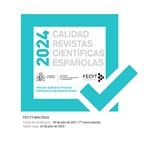Escribanos y fortalecimiento del poder real en Castilla. La institución del escribano público en las Partidas. (RI §423226)

The public notaries and Royal Power strengthening in Castile. The public notaries institution in las
Partidas -
Rafael Jesús Vera Torrecillas
El presente trabajo se plantea como un estudio introductorio del régimen jurídico de los escribanos públicos que Alfonso X recogió en su obra legislativa (el Fuero Real, el Espéculo y las Partidas) y que marcan el verdadero inicio del Derecho notarial español. Es en el siglo XIII cuando surgen las primeras ordenaciones legales relativas al oficio notarial, fruto de la recepción en la península ibérica de los conceptos y terminología que, sobre el notariado y el documento público, ya habían florecido en Italia de la mano de Derecho romano postclásico y del Derecho canónico Nuestra hipótesis de trabajo es que la institución del escribano fue institucionalizada por Alfonso X con un objetivo eminentemente político de fortalecimiento del poder real, para lo cual se sirvió de la doctrina que sobre esta institución ya se había consolidado en el Derecho canónico, fundamentalmente a partir de las Decretales de Gregorio IX, y de toda la teoría sobre el documento público procedente de los juristas de la Escuela de Bolonia.
I. Introducción. II. Orígenes altomedievales del escribano: Del Tabellio romano a los scriptores y los notarios del officiumpalatinum. III.El nacimiento del InstrumentumPublicum y el oficio del escribano público en el contexto político del siglo XIII. 3.1. El Escribano como instrumento al servicio del poder real. 3.2. Escribanos y documentos. La influencia del ius canonicum en la ordenación legal del documento público. IV. La recepción en la península ibérica de la institución: La influencia del modelo italiano. V. Del Scriptor al Escribano Público en Castilla. Tipos de Escribanos en la Baja Edad Media. VI. La regulación notarial y el sistema documental en las Partidas. 6.1. La institución y funciones del escribano en las Partidas (P.3.19). 6.2 La teoría del instrumento público en las Partidas (P. 3.18). VII. Conclusiones. VIII. Bibliografía. IX. Fuentes Documentales.
This article is an introductory study of the legal regime of public notaries established in the legislative works of Alfonso X (Fuero Real, Espéculo and Partidas) and which heralded the true beginning of Spanish notarial law. The first legal ordinances concerning the notarial profession appeared in the thirteenth century, after the arrival within the Iberian peninsula of concepts and terminology regarding notaries and public documents that had flourished in Italy as a result of Post-Classical Roman Law and Canon Our working hypothesis is that the notary profession was institutionalised by Alfonso X with an eminently political objective of bolstering royal power, for which he made use of the legal principles already consolidated in Canon Law, fundamentally based on the Decretals of Gregorio IX, and on all the theory on public documents developed by the jurists of the School of Bologna.
I. Introduction. II. Early medieval origins of the public notaries: from the Roman Tabellio to the scriptors and notaries of the Officium Palatinum. III. The advent of the Instrumentum Publicum and the office of public notaries in the political context of the thirteenth century. 3.1. The public notaries as an instrument at the service of royal power. 3.2. Public notaries and documents. The influence of Canon Law on the legal system of the public document. IV. The reception of the institution on the Iberian Peninsula: the influence of the Italian model. V. From scriptor to public notaries in Castile. Types of public notaries in the Late Middle Ages. VI. Notarial regulation and the documentary system in the Partidas. 6.1. The institution and functions of the public notaries in the Partidas (P.3.19). 6.2 The theory of the public instrument in the Partidas (P. 3.18). VII. Conclusions. VIII. References. IX. Documentary sources.

 DIRECTORA
DIRECTORA